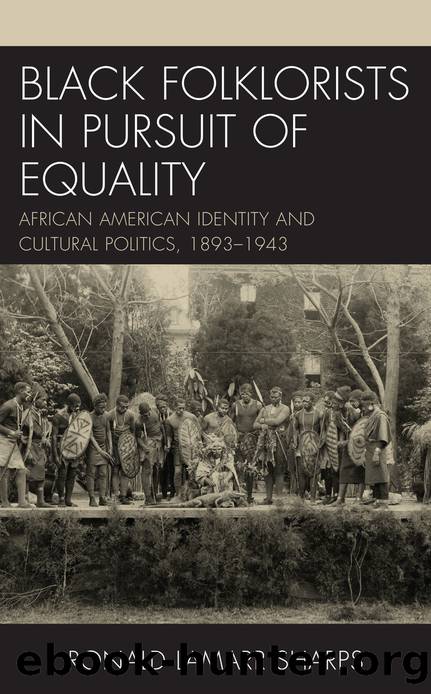Black Folklorists in Pursuit of Equality by Ronald LaMarr Sharps

Author:Ronald LaMarr Sharps
Language: eng
Format: epub
Publisher: Lexington Books
Published: 2023-06-05T00:00:00+00:00
NOTES
1. E. Pearl Edwards, âDr. Motonâs Talk,â Hampton Student, July 15, 1918, 9.
2. Thomas E. Davis, âClose Ranks,â Hampton Student, May 15, 1916, 1.
3. W. E. B. Du Bois, âOpinion: Close Ranks,â Crisis 16 (July 1918): 111.
4. Robert Russa Moton, Finding a Way Out: An Autobiography (Garden City, NY: Doubleday, Page, 1921), 253; W. E. B. Du Bois, âOpinion: Robert R. Moton,â Crisis 18 (May 1919): 9â10.
5. John Hope Franklin and Alfred A. Moss, Jr., From Slavery to Freedom: A History of African Americans (Boston: McGraw Hill, 2000), 360.
6. Moton, Finding a Way Out, 25â53.
7. Grace Bigelow House, âOrigin of the Hymn of Freedom,â SW 47 (October 1918): 475â78.
8. Editorial Correspondence, âThe Negro Kingdom by the Sea, Port Royal and Other Sea Islands,â SW (March 1887): 25â26; âOn the Sea Islands,â SW (July 1900): 388â89; George Brown Tindall, South Carolina Negroes, 1877â1900 (Columbia: University of South Carolina Press, 1952), 6â7, 102â3, 218â23; Idus A. Newby, Black Carolinians: A History of Blacks in South Carolina from 1895 to 1968 (Columbia: University of South Carolina Press, 1973), 102â7; Alrutheus Ambush Taylor, The Negro in South Carolina During Reconstruction (New York: AMS Press, 1924, 1971), 82â85. For a history of the school, see J. E. Davis, âA Unique Peopleâs School,â SW 43 (April 1914): 217â30.
9. J. E. Blanton, âI Sho Ben Lub Dat Buckra,â SW 37 (April 1908): 242.
10. Cora M. Folsom, review of Negro Folk-Songs: Hampton Series, Book II, by Natalie Curtis Burlin, SW 47 (October 1918): 475â77; Gary Alan Fine and Patricia A. Turner, Whispers on the Color Line: Rumor and Race in America (Berkeley: University of California Press, 2001); Natalie Curtis Burlin, âHymn of Freedom,â SW 47 (October 1918): 475â77; For background see Michelle Wick Patterson, Natalie Curtis Berlin: A Life in Native and African American Music (Lincoln: University of Nebraska Press, 2010).
11. Spread from England to the United States in the 1850s, the Young Menâs Christian Association, which saw its mission as building character, started organizing âColoredâ Ys in America in 1898. See David I. Macleod, Building Character in the American Boy: The Boy Scouts, YMCA, and Their Forerunners, 1870â1920 (Madison: University of Wisconsin Press, 1983), 214. See also Kelly Miller, âThe Negro Young Menâs Christian Association, SW 33 (February 1904): 93.
12. J. E. Blanton, âMen in the Making,â SW 48 (January 1919): 17â24; and J. E. Blanton, Columbia, SC, to William Anthony Aery (1883â1963), Hampton Institute, Hampton, VA, letter, September 9, 1918, Hampton University Archives, Hampton, VA.
13. W. Kirkpatrick Brice, Chair, National Committee on Army and Navy Camp Music, Music in the Camps, November 3, 1917, 1â2, 5; Kenneth N. Westerman, âThe Folk Song and the Opera,â Music in the Camps, March 18, 1919, 1â2; Howard Wade Kimsey, âSan Antonio, TX,â Music in the Camps, July 13, 1918, 4; Herbert W. Owen, âKey West Training Station, Miami, FL,â Music in the Camps, November 23, 1918, 3; âPlans for Military Singing,â Music in the Camps, February 22, 1919, 1; Ernest A. Ebel, âBensonhurst Naval Station, Brooklyn, NY,â Music in
Download
This site does not store any files on its server. We only index and link to content provided by other sites. Please contact the content providers to delete copyright contents if any and email us, we'll remove relevant links or contents immediately.
The Power of Myth by Joseph Campbell & Bill Moyers(1015)
Half Moon Bay by Jonathan Kellerman & Jesse Kellerman(958)
Inseparable by Emma Donoghue(941)
A Social History of the Media by Peter Burke & Peter Burke(940)
The Nets of Modernism: Henry James, Virginia Woolf, James Joyce, and Sigmund Freud by Maud Ellmann(837)
The Spike by Mark Humphries;(771)
The Complete Correspondence 1928-1940 by Theodor W. Adorno & Walter Benjamin(753)
A Theory of Narrative Drawing by Simon Grennan(747)
Culture by Terry Eagleton(726)
Ideology by Eagleton Terry;(700)
Bodies from the Library 3 by Tony Medawar(683)
World Philology by(680)
Farnsworth's Classical English Rhetoric by Ward Farnsworth(676)
Game of Thrones and Philosophy by William Irwin(671)
High Albania by M. Edith Durham(660)
Adam Smith by Jonathan Conlin(651)
A Reader’s Companion to J. D. Salinger’s The Catcher in the Rye by Peter Beidler(649)
Comic Genius: Portraits of Funny People by(618)
Monkey King by Wu Cheng'en(613)
